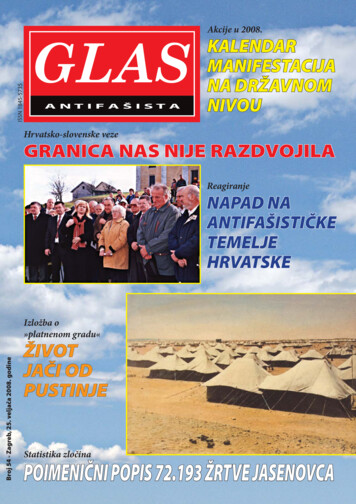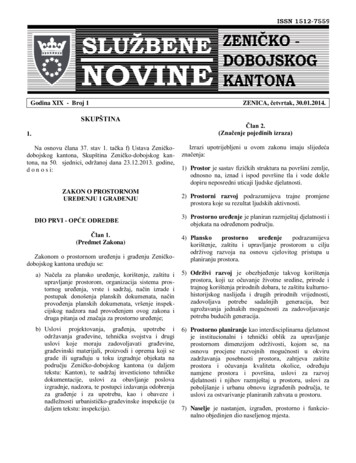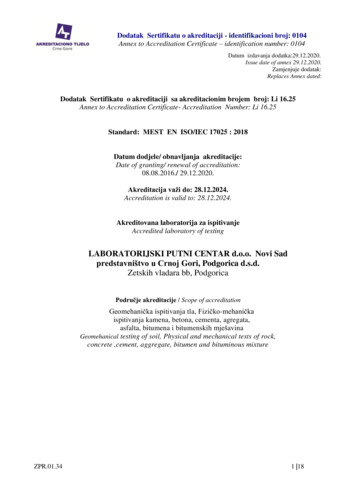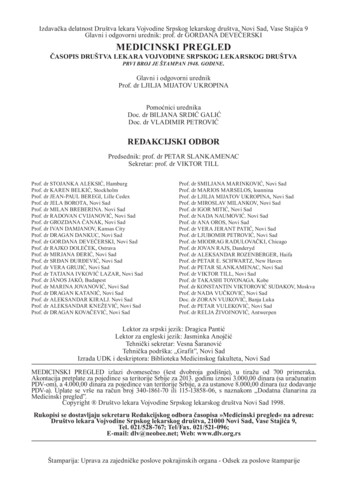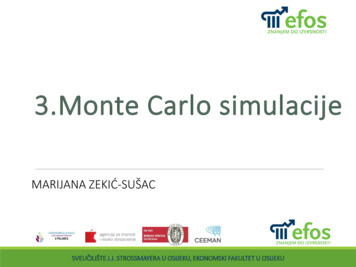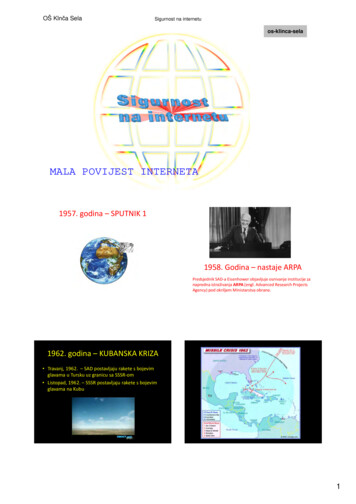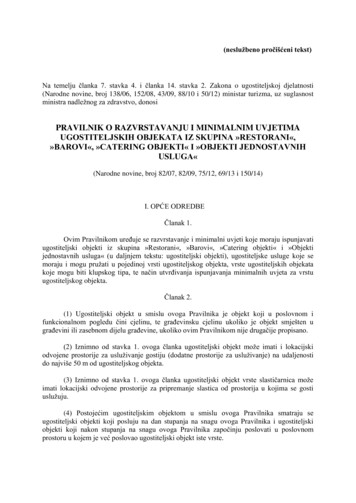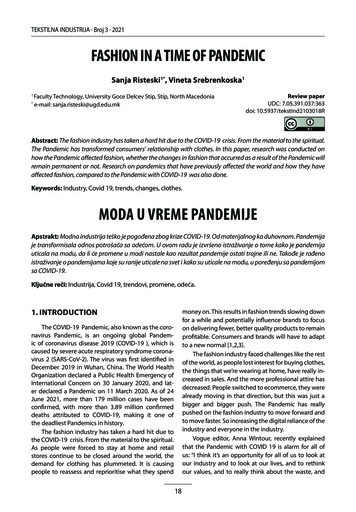
Transcription
TEKSTILNA INDUSTRIJA · Broj 3 · 2021FASHION IN A TIME OF PANDEMICSanja Risteski1*, Vineta Srebrenkoska11*Faculty Technology, University Goce Delcev Stip, Stip, North Macedoniae-mail: sanja.risteski@ugd.edu.mkReview paperUDC: 7.05.391.037:363doi: 10.5937/tekstind2103018RAbstract: The fashion industry has taken a hard hit due to the COVID-19 crisis. From the material to the spiritual.The Pandemic has transformed consumers’ relationship with clothes. In this paper, research was conducted onhow the Pandemic affected fashion, whether the changes in fashion that occurred as a result of the Pandemic willremain permanent or not. Research on pandemics that have previously affected the world and how they haveaffected fashion, compared to the Pandemic with COVID-19 was also done.Keywords: Industry, Covid 19, trends, changes, clothes.MODA U VREME PANDEMIJEApstrakt: Modna industrija teško je pogođena zbog krize COVID-19. Od materijalnog ka duhovnom. Pandemijaje transformisala odnos potrošača sa odećom. U ovom radu je izvršeno istraživanje o tome kako je pandemijauticala na modu, da li će promene u modi nastale kao rezultat pandemije ostati trajne ili ne. Takođe je rađenoistraživanje o pandemijama koje su ranije uticale na svet i kako su uticale na modu, u poređenju sa pandemijomsa COVID-19.Ključne reči: Industrija, Covid 19, trendovi, promene, odeća.1. INTRODUCTIONmoney on. This results in fashion trends slowing downfor a while and potentially influence brands to focuson delivering fewer, better quality products to remainprofitable. Consumers and brands will have to adaptto a new normal [1,2,3].The fashion industry faced challenges like the restof the world, as people lost interest for buying clothes.the things that we’re wearing at home, have really increased in sales. And the more professional attire hasdecreased. People switched to ecommerce, they werealready moving in that direction, but this was just abigger and bigger push. The Pandemic has reallypushed on the fashion industry to move forward andto move faster. So increasing the digital reliance of theindustry and everyone in the industry.Vogue editor, Anna Wintour, recently explainedthat the Pandemic with COVID 19 is alarm for all ofus: “I think it’s an opportunity for all of us to look atour industry and to look at our lives, and to rethinkour values, and to really think about the waste, andThe COVID-19 Pandemic, also known as the coronavirus Pandemic, is an ongoing global Pandemic of coronavirus disease 2019 (COVID-19 ), which iscaused by severe acute respiratory syndrome coronavirus 2 (SARS-CoV-2). The virus was first identified inDecember 2019 in Wuhan, China. The World HealthOrganization declared a Public Health Emergency ofInternational Concern on 30 January 2020, and later declared a Pandemic on 11 March 2020. As of 24June 2021, more than 179 million cases have beenconfirmed, with more than 3.89 million confirmeddeaths attributed to COVID-19, making it one ofthe deadliest Pandemics in history.The fashion industry has taken a hard hit due tothe COVID-19 crisis. From the material to the spiritual.As people were forced to stay at home and retailstores continue to be closed around the world, thedemand for clothing has plummeted. It is causingpeople to reassess and reprioritise what they spend18
TEKSTILNA INDUSTRIJA · Broj 3 · 2021the amount of money, and consumption, and excessthat we have all indulged in and how we really needto rethink what this industry stands for.” In this hardPandemic times some fashion brands struggle tosurvive, while others have found ways to thrive morethan ever. Alessandro Michelle, the creative directorof Gucci also thinks that it is time for changes, so hewants to end midseason fashion collections by reducing the number of shows from five to two each year.Also, design processes are being reconsidered inlight of COVID-19 . In recent months, some of the mostinfluential members within this stage of the fashionindustry, such as the British Fashion Council, Councilof Fashion Designers of America, and a group facilitated by Business of Fashion under the mantle RewiringFashion, have noted that the Pandemic provides anopportunity to fundamentally overhaul the industryand lead to a completely new, slower, fashion system.As Balmain designer Oliver Rousteing told Vogue, inlight of COVID-19 , “we are no longer in a time of beingthe trend of the season. I don’t want to be cool, cool’sover. Chic’s over. You’re cool for two months thesedays. It used to be two years. Who wants to be partof that?”. This reimagined industry would be basedupon fewer trends, seasons, fashion weeks, and collections. It also aims to support new fashion buyingand consumption behaviors and to reduce the industry’s dependence on discounting. The biggest impactby Pandemic with COVID-19 will be felt by physicalstores, as many customers remain fearful to enterlarge retail spaces. Moreover, even in countries wheredirect shopping is still allowed, brands are pivotingfast to digital sales, especially if they want to remainprofitable.However, with all its negative and tragic parts,the arrival of COVID-19 has initiated a bit of positivechange. Big brands such as Ralph Lauren, KennethCole, Burberry, and Chanel, are pitching in to help withrelief efforts. After a year in which the fashion industryposted record-low economic profits, business leadersare on the front foot, seeking to innovate while continuing to engage their core constituencies. The Stateof Fashion 2021 report, has remained relatively insulated from the Pandemic, offering consumers a comforting pick-me-up in challenging times.There is little doubt that 2021 will continue to betough for many as the COVID-19 Pandemic tracks anuncertain trajectory. Fashion companies that doubledown on strategy, align with key trends, and reflectan evolving consumer landscape are likely to emergefrom the crisis stronger, leaner, and ready to thrive inthe next normal. The crisis has accelerated the use ofdigital and believe that the opportunities and para-digm shifts that have emerged will persevere postcrisis. Companies will communicate, engage, and interact with customers in new ways. At the same time,consumption is changing. Because consumers arelooking for purpose and sustainability, a company’smission is becoming more important than ever. Andbecause the next normal is here to stay, fashion companies must be ready to embrace innovation [4,5,6,7].2. HISTORY OF PAST PANDEMICS ANDHOW THEY INFLUENCED FASHIONIn the realm of infectious diseases, a Pandemic isthe worst case scenario. When an epidemic spreadsbeyond a country’s borders, that’s when the diseaseofficially becomes a Pandemic.2.1. 1918 Pandemic (H1N1 virus)In the 1918 influenza Pandemic was the most severe Pandemic in recent history. It was caused by anH1N1 virus with genes of avian origin. Although thereis not universal consensus regarding where the virusoriginated, it spread worldwide during 1918-1919. Inthe United States, it was first identified in military personnel in spring 1918. It is estimated that about 500million people or one-third of the world’s populationbecame infected with this virus. The number of deathswas estimated to be at least 50 million worldwide withabout 675,000 occurring in the United States. In thistime wearing face masks in public was encouragedby health officials (in some places required, with thethreat of a 5 fine for noncompliance). Through thefall of 1918, sales of blankets, comforters and winterunderwear were up, while sales of ready-to-wear andchildren’s wear were hard hit. (Many mothers wereafraid to take their children to stores.) Suit sales alsodropped.In that hard Pandemic times woman were wearinga heavy chiffon veil all the time when they were outside on the streets. It may become necessary to ordereveryone in New York to adopt this measure. Theseveils were very thick and served as an almost absolutepreventative. The veils being chosen take on the colorof the hat. Another product, the Safety First Veil, wasdesigned by Stern & Stern, “a mesh veil with a chiffonborder in harem effect,” not unlike today’s face shields.Wearing gloves was still part of men’s and women’s etiquette at the time of the Pandemic. The generationsthat lived through the Spanish flu had come out ofveiling, but picked it up again, so it became a perfectexcuse to also be able to cover the face.19
TEKSTILNABrojof3 ·veiling,2021 but picked it up again, so it became aough the Spanishflu INDUSTRIJAhad come ·oute to also be able to cover the face.far less pronounced without the 1918 Pandemic, particularly in textiles. The increased number of womenin textile manufacturing gave rise to a stylistic reorientation, and the 1920s welcomed the success of revolutionary female fashion designers including CocoChanel, Elsa Schiaparelli, Jeanne Lanvin and Madeleine Vionnet [9,10].hrough the Spanish flu had come out of veiling, but picked it up again, so it became ause to also be able to cover the face.Figure 1. Safety first veil [6]Figure 1. Safety first veil [6]tective masks weremadeof gauzemasksor evenmoreporousmaterial (Figure 2). In 1918,The faceprotectiveweremadeof gauzeasks like thethat poroushealthcareworkersuse2).todaywereor N95'seven morematerial(FigureIn 1918,ad-a long way off. Surgicalmade of gauze,andmanypeople’sflumasksweremadevanced masks like the N95’s that healthcare workersof gauze too. Red Crossade and distributed many of these, and newspapers carried instructions for those whouse today were a long way off. Surgical masks weremake a mask for themselves or donate some to the troops. Still, not everyone used theof gauze,manyDetroitpeople’sflu masksweregical design madeor material.For andinstance,healthcommissionerJ.W. Inches said thatmade oftoo.Crossofvolunteersmade theandpublic. Also, masks weres were too porousto gauzepreventtheRedspreadthe flu amonge when worndistributedproperly, whichalwayshappened[6, 7, 8].many wasn’tof these,and whatnewspaperscarried21 period on and it'sinstructions for those who may want to make a maskcurately datefashionduringthisperiod,asopposedtoothererasof the 20th centuryFigure1.Safetyfirstveil[6]for themselves or donate some to the troops. Still,nal changes are easy to recognise. In this time women’s increased presence in thenot everyoneusedgauzethe standardsurgicaldesignor (Figure 2). In 1918,protectivemasksor evenmoreporousmaterialould havebeenwerefar madeless ofpronouncedwithoutthe 1918Pandemic, particularly ongway off.reorientation,Surgicalncreased number of women in textile manufacturing gave rise toa sksweretooporous0s welcomed the success of revolutionary female fashion designers he spreadof the flu Vionnetamong [9,10].the public.Schiaparelli,toJeanneand Madeleineo make a mask for themselves or donate some to the troops. Still, not everyone used theAlso, masks were most effective when worn properly,urgical design or material. For instance, Detroit health commissioner J.W. Inches said thatFigure3. 1918-1919, women walking in Londonalwayshappened[6,among7, 8]. the public. Also,sks were too whichporouswasn’tto preventthewhatspreadof1918-1919,the flumasks were in London during theFigure3.womenwalkingduringthe Spanish Flu pandemic [9]ive when worn properly,which wasn’thappened7, 8].The 1918-1921periodalwayswas a whatconfusedera in[6,fash-1921 period ionwastherea confusedera in fashionthere andwasit’snodifficultobvious progression and it'swas no obviousprogressionaccurately date fashion during this period, as opposed to other eras of the 20th centuryto accuratelydatefashion Induringthis period,asincreasedopsonal changesare easy torecognise.this timewomen’spresencethe Pandemic (H2N2 urywhereseasonwould have been far less pronounced without the 1918 Pandemic, particularly inIn reorientation,February 1957, a new influenza A (H2N2) viruse increased numberof womentextilemanufacturinggaverise to a stylistical changesare easyintorecognise.In this timewomen’s920s welcomedthe successof in EastAsia, triggering a Pandemic (“Asianincreasedpresencethe workforcewouldfashionhave beensa Schiaparelli, Jeanne Lanvin and Madeleine Vionnet [9,10].2.2.Spanis1957- 1958 Pandemic (H2N2 virus)In February 1957, a new influenza A (H2N2) virus emerged in East AsFlu”). ThisH2N2 virus wasofcompriseddifferent genes(“Asian Flu”). This H2N2 virus wascomprisedthreeof threedifferentgenes from an H2N2 virus that originated from an avioriginated from an avian influenzaanAinfluenzavirus,Aincludingthe H2 hemagglutininvirus, including the H2 hemagglutiningenes. It was first reported in Singaporein [8]February1957,Hongand flutheinN2neuraminidasegenes.It was firstreport-Kong inWomen working for the Red Cross make masks during the pandemic1918ed in Singaporein FebruaryHong Kong in Aprilcities in the United States in summer1957.The1957,estimatednumber dwide and 116,000 in the United States. The rapid development of amer 1957. The estimated number of deaths was 1.1virus and the availability of antibioticsto treat secondary infections limited tmillion worldwide and 116,000 in the United States.the Pandemic [11,12].The rapid development of a vaccine against the H2N2virus and the availability of antibiotics to treat secondary infections limited the spread and mortality of2. Women working for the Red Cross make masks during the pandemic flu in 1918 [8]the Pandemic [11,12].Figure 2. Women working for the Red Cross makemasks during the pandemic flu in 1918 [8]20
referred to as “sack dresses” (Figure 5). The important thing is that peates in summer 1957. The estimated number of deaths was 1.1 millionlittlemore States.freedomit came tofashionThe whenrapid developmentof atheirvaccineagainst choices.the H2N2 No longer diinthe Unitedof antibioticstoto atreatsecondarylimitedsituations.the spread andmortalityof the year in wconformcertainlookinfectionsfor certain1957wasbecame “an adjective in her own time.TEKSTILNA INDUSTRIJA · Broj 3 · 2021ears a mask to protect against Asian flu in the UK, 1957. Photograph: DailyFigure4. AArchive/SSPL/Gettytypist wears a mask to protectagainstHerald[11].Asian flu in the UK, 1957. Photograph: Daily HeraldArchive/SSPL/Getty [11].People during Asian Flu Pandemic wore masks(Figure 4), but most of the people didn’t adopt a sixfeet-apart rule. The Pandemic itself lasted a short time(one year), because a vaccine was discovered veryquickly. Тhere is not much written evidence of the impact of this pandemic on fashion, but in general, fashion in the 1950s varied greatly from the beginning toend. Maybe not quite as extreme as the ’60s, 1950sfashion saw the introduction of many new styles aswell as many styles that paid homage to the 1920s.The waistline was a major issue in the 1950s. Somewomen really like the snug fit of the Dior dresseswhile others liked the dresses with no waistline, oftenreferred to as “sack dresses” (Figure 5). The importantthing is that people were beginning to feel a littlemore freedom when it came to their fashion choices.No longer did people feel like they had to conform toa certain look for certain situations. 1957 was the yearin which Gabrielle “Coco” Chanel became “an adjective in her own time.Short, non-fitted suit jackets often strung withbrass buttons and pockets, almost always opened toshow the blouse inside, sleeves peeled back to showa shirt’s cuffs, magnificent fakes, “pearls” and coloredstones looped round the throat, or a jeweled Maltese cross winking on a lapel, Bretons perched on theback of the head, pull-overs that matched a jacket’slining, jerseys, tweeds, brocades, lace evening dresses- all were stamped with elegant nonchalance. Thebest news about the new fashion for many men whobemoaned the disappearance of the female waistlinewas that it meant higher hemline. And that in turnmeant the longer the leg, the lower the heel of theshoe, and women finally started climbing down fromthe stiletto heel, but still clung to the stiletto toe [13].Figure5. 1957''Sack‘’Sack Dress“Dress“[13]Figure 5.1957[13]1.3. 1968withPandemic(H3N2virus)Short, non-fitted suit jackets often strungbrassbuttonsand pockThe 1968 Pandemic was caused by an influenzashow the blouse inside, sleeves peeledback to show a shirt’s cuffs, mA (H3N2) virus comprised of two genes from an avian influenzaorA virus,a new MalteseH3 hemagglu- crosscolored stones looped round the throat,a includingjeweledtinin, but also contained the N2 neuraminidase fromperched on the back of the head, pull-oversthat matched a jacket’s lininthe 1957 H2N2 virus. It was first noted in the UnitedStates in September1968. The estimatednumber oflace evening dresses- all were stampedwith elegantnonchalance.Tdeaths was 1 million worldwide and about 100,000fashion for many men who bemoanedthe States.disappearanceofin thein the UnitedMost excess deaths werepeo- femaple 65theyears longerand older. The1968leg,flu Pandemicwasahigher hemline. And that in turn meantthethelowertheglobal outbreak of influenza that originated in Chinafinally started climbing down from thein Julystilettoheel,but1969–70.still Theclungto the s1968 andlasted untilDivision2.3.of Biologics Standards of the National Institutes ofHealth provided the A/Hong Kong/1968 (H3N2) vaccine virus to manufacturers in August 1968. However,before manufacturers had completed studies to determine its feasibility for producing a Pandemic vaccine, a new vaccine virus became available. This virus,the Aichi strain from Japan, demonstrated superiorvaccine production potential and was supplied tomanufacturers on September 9, 1968, and incorporated into a monovalent Pandemic influenza vaccine[14,15,16,17].1968 Pandemic (H3N2 virus)The 1968 Pandemic was caused by an influenza A (H3N2) virus comavian influenza A virus, including a new H3 hemagglutinin, but also confrom the 1957 H2N2 virus. It was first noted in the United States in Senumber of deaths was 1 million worldwide and about 100,000 in thedeaths were in people 65 years and older. The 19621global outbreak of influenza that originatedin China in July 1968 andDivision of Biologics Standards of the National Institutes of Health pro
Skimmer dresses were very popular (Figure 7). They fit straight on the body with a h(usually) a belt to define the waist, but not shape it. They “skimmed” the body withskin. They also hovered above the knee.TEKSTILNA INDUSTRIJA · Broj 3 · 2021ages. Womenswear followed three broad trends: a continuation of the previous decade’s ladylike elegance,the youthful styles of Mary Quant and the Space Ageinfluence, and the late 1960s “hippie” style. Menswearsaw an increasing amount of color and pattern (Figure8), military influence, and new fashion icons in the formof rock stars. Children’s wear saw less change, but alsobecame more casual and bright in color and pattern.Skimmer dresses were very popular (Figure 7). Theyfit straight on the body with a high neckline and (usua)ally) a belt to define the waist, butb)not shape it. TheyFigure 7. a) 1968 SkimmerDress WithTie withoutBelt, DropWaisttheDress,“skimmed”the bodytouchingskin. andThey Shift DressShiftalsoDressesWomen,hoveredforabovethe knee.source: vintage dancer [19]Figure 6. Hong Kong Flu 1968-1969 [18]e relaxed ideas about viruses, the Hong Kong flu caught the world by sprevious Pandemics because of how fast it spread, thanks largelyr travel. The Hong Kong flu also arrived at a particularly volatile momrace to land a man on the moon and political assassinations and sexuamovement. But, even if people in 1968 had been told to stay home, itsted [18].PeopleworeFlumasksto protect their self from the virus spreadFigure6. 6.Hong1968-1969FigureHongKongKong Flu 1968-1969[18] [18]his Pandemic on fashion was not significant as the Pandemic in 1918.laxed ideas aboutviruses,the HongcaughtEven withthose relaxedideasKongaboutfluviruses,the the world by surprise. It wasprogressivelymorecasualacrossall genders and ages. Womenswearvious Pandemicsof worldhowbyfastit spread,Hong Kongbecauseflu caught thesurprise.It was dif- thanks largely to increasedThe HongKongflu alsoarrivedat a particularlymoment in elegance,history.ferent frompreviousPandemicsbecauseof howfast ade’sthe youthfulspread,largelyandto increasedaire to land aitmanonthanksthe moonpoliticalinternationalassassinationsand sexual liberation andSpaceAgeandthelateto stay1960sMenswear sawtravel.The HongKong influ 1968also arriveda particularlyvement.But,evenifinfluence,peoplehad atbeentoldhome,“hippie”it’s unlikely style.theyvolatilemomentin history.Therewastheselfrace tolandinfluence,a virus spreadingPeopleworemasksto aryand(Figurenew6).fashion icons in emic on fashion was not significant as the Pandemic in 1918. Fashion in ecamemorecasualliberationandacrossthecivil rightsmovement.But,evencasualall gendersages.Womenswearfollowedthree and bright in nuationof the previousdecade’s ladylike 1968ColoredSkinnyTies, andwithCufflinks,es werepopular7).masksTheystraightonthe bodya higlikelyverythey would’veprotested(Figure[18]. People woreFigure8.1968ColoredShirts, Skinny Ties,ace Age influence, and the late 1960s “hippie” style. Menswear saw an increasingto protecttheirwaist,self from thebutvirus spreading(Figure 6). it. TheyandinCufflinks,source:vintage dancerdefinethenotthe [20]body withoundtopattern(Figure8), military influence,and shapenew fashioniconsthe“skimmed”formof rockThe impact of this Pandemic on fashion was not signifearsaw lesschange,but thealsobecamemore casual and bright in color and pattern.hoveredaboveknee.icant asthe Pandemicin 1918.Fashion in the 1960s beFound in a variety of fabrics colors and patterns,were very camepopular(Figure more7). Theystraighton thewith a high neckline andprogressivelycasualfitacrossall gendersandbodythe “dirndl skirt” was appropriate for work or play. Mutdefine the waist, but not shape it. They “skimmed” the body without touching thevered above the knee.a)b)8 Skimmer Dress With Tie Belt, Drop Waist Dress, and Shift Dress b) 1968 KnitShift Dresses for Women, source: vintage dancer [19]a)a)b) b)Figure 7. a) 1968 Skimmer Dress With Tie Belt, Drop Waist Dress, and Shift Dress b) 1968 Knit Shift Dresses1968 Skimmer Dress WithBelt,Waistfor TieWomen,source:Dropvintage dancer[19] Dress, and Shift Dress bShift Dresses for Women, source: vintage dancer [19]22
TEKSTILNA INDUSTRIJA · Broj 3 · 2021ed shades and glen plaids were particularly popular inFor people was hard to find the essential effecblends that give a linen look. Gently gathered at the tiveness of a face mask, and also thought that socialFigure 9. An Afghan boy tries to sell protective masks on a market in Kabul [2waistline, one dirndl in gray rayon-silk blended fabric distancing was effective, as well as keeping space 6was topped with a blue and blackshirtof to feetbetween ofpeople.For tattersallpeople washardfindwasthe recommendedessential effectivenessa face mask, and also thougcotton oxford cloth. The waistlinedistancingwas accentedwithathis Pandemicfelt recommendedbored of plain between pewas effective, as Peoplewell asinkeepingspace 6 timesfeet wasbelt, ever-present this year. For variety,flared bluePeoplepleated,in this Pandemictimesplain blueor dullmedicalor me masks likeMexicanstaken toMexicanscustomisinggear, so theyvery fashionabland A-line skirts were still popularwith thehaveemphasishave theirtakenfacialto customisingtheirlookedfacial gear,remaining on the waistline. Belts[21,22,23].and cummerbunds so they looked very fashionable and stylish [21,22,23].are added to achieve the 1968 look [19,20].source: vintage dancer [20]1.4. 2009 H1N1 Pandemic(H1N1pdm09 virus)rics colors and patterns, the “dirndl skirt” was appropriate for work or play.In the spring of 2009, a novel influenza A (H1N1)plaids wereparticularly popular in blends that give a linen look. Gentlyvirus emerged. It was detected first in the United, one dirndlgrayrayon-silkblendedfabricwas topped with a blue andStatesinandspreadquickly acrossthe UnitedStatestton oxfordTheThiswaistlinewasaccenteda belt, ever-present thisandcloth.the world.new ot previous, flared andA-lineskirts ofwerestillgenespopularwith the emphasis remaining only identifiedin animalspeople. Thiswaslookdes- [19,20].ummerbundsare addedto orachievethevirus1968ignated as influenza A (H1N1)pdm09 virus. Ten yearsFigure 10. Swine flu: custom face masks take to Mexico's streets [23]Figure 10. Swine flu: custom face masks take tolater work continues to better understand influenza,ic (H1N1pdm09virus)Mexico’s streets [23]prevent disease, and prepare for the next Pandemic.3.COVID-19PANDEMIC(CURRENT)Though the 2009 flu Pandemic primarily affected chilnovel influenza(H1N1)virus emerged.It impactwas detectedfirst inPANDEMICthe United(CURRENT)2. COVID-19dren andAyoungand middle-agedadults, they across theStatesvirusandworld.populationThis new H1N1 virus contained aof theUnited(H1N1)pdm09on thethe globalThepeople.COVID-19 ThisPandemic,alsowasknown as the coronavirusduring theyear was lessidentifiedsevere than thatof previ- orluenza genesnotfirstpreviouslyin animalsvirusPandemic,isanongoingglobalPandemic of coronavious Pandemics.Estimatesof PandemicmorA (H1N1)pdm09virus.Ten yearslaterinfluenzawork continuesto betterunderstandrus disease2019 (COVID-19), which is caused by severetality rangedforfrom0.03nextpercentof the world’s populase, and preparethePandemic.Though acutethe respiratory2009 flusyndromePandemiccoronavirus 2 (SARS-CoV-2).tion during the 1968 H3N2 Pandemic to 1 percent toTheviruswas first identifiedvirusin December 2019 in Wun and 93 percent of the world’s population during the 1918han,China.TheWorldHealthOrganization declaredduring theyearItwasless thatseverethan thatH1N1firstPandemic.is estimated0.001 percentto of previous Pandemics.a Public Health Emergency of International Concern onnfluenza mortalityrangedfrom 0.03percentofresthe world’spopulation during0.007 percentof the world’spopulationdied of30 January 2020, and later declared a Pandemic on 11piratorytocomplicationswith (H1N1)pdm09c to 1 percent3 percentassociatedof the world’spopulationduringtheon1918March2020. As29 JuneH1N12021, more than 181 sd that 0.001 percent to 0.007 percent of the world’spopulationdiedcases havebeen confirmed,withofmore than 3.92 nfirmeddeathsattributedtoCOVID-19,making it oneassociated with (H1N1)pdm09 virus infection during the first 12 months thefluenza Pandemic that lasted about 19 months, from of the deadliest Pandemics in history.09 swine Januaryflu Pandemicwas an influenza Pandemic that lasted about 192009 to August 2010.Although the exact origin of the virus is still unknown, [24]09 to August 2010.the first outbreak started in Wuhan, Hubei, China in late2019 [25,26,27]. On 11 February 2020, the World HealthOrganization (WHO) named the disease «COVID-19 “,which is short for coronavirus disease 2019 [28,29,30,31].Afghan boy1.1. COVID-19 fashion: Out with thedress codeOne of the many industries not immune to the effects ofCOVID-19 was the fashion industry. Granted, there wasa major spike in online sales and a demand for comfortable “work from home” clothes, but it wasn’t enough tomake up for the overall drop in sales and hit on the global economy. The industry faced challenges like the restof the world, as people lost interest for buying clothes.triestosellprotectivemasksonamarketin Kabul[22] working with overseas manufacManybrands stoppedFigure 9. An Afghan boy tries to sell protectivetures because it was too expensive, which also inspiredmasks on a market in Kabul [22]ind the essential effectiveness of a face mask, and also thought that socialas well as keeping space 6 feet was recommended between people.23 masks like before, sometimes felt bored of plain blue or dull green medicalcustomising their facial gear, so they looked very fashionable and stylish
TEKSTILNA INDUSTRIJA · Broj 3 · 2021consumers to shop more consciously. While not as comfortable, high fashion was also forced to have an onlinefocus, especially during fashion weeks [32].but it’s only a branch of this larger evolution.Comfort dressing -or ‘quarantine style -was a fashion force to be reckoned with during COVID-19 . TomSimpson, fashion director of online retailer The Iconic,said they saw a “huge demand” for athleisure brandswhen the country first went into lockdown. “If therewas a number one item in fashion in Australia in thepast six months, it was a sweat top and a pair of sneakers,” so, “It’s made people realise that you can dressmore comfortably, and still work well.” One of Australia’s most popular active wear labels, P.E Nation, saw asimilar surge. “There has been a massive spike in salesof hoodies, sweats and track pants, along with the consistent sell through of leggings and active looks acrossthe board.”1.2. Will the COVID-19 Pandemicchange how people dress for work inthe future?With nowhere to go and hardly anyone to impress,the vast majority of people in the time of Pandemiawith Covid -19, spent more time in their pajamas thanthey would care to admit. And it wasn’t just
from the crisis stronger, leaner, and ready to thrive in the next normal. The crisis has accelerated the use of digital and believe that the opportunities and para-digm shifts that have emerged will persevere post-crisis. Companies will communicate, engage, and in-teract with customers in new ways. At the same time, consumption is changing.



